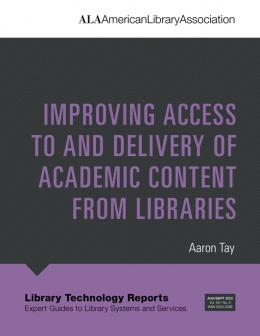Primary tabs
You don't need to be an ALA Member to purchase from the ALA Store, but you'll be asked to create an online account/profile during the checkout to proceed. This Web Account is for both Members and non-Members.
If you are Tax-Exempt, please verify that your account is currently set up as exempt before placing your order, as our new fulfillment center will need current documentation. Learn how to verify here.
- Description
- Table of Contents
- About the authors
While academic libraries have traditionally focused on discovery, helping users to seamlessly access resources available behind a paywall is becoming equally important. The emergence of Sci-Hub into the public eye has led not only to more academic piracy but also to the discovery that academic users were using Sci-Hub for the sheer convenience of not needing to authenticate. This and other reasons have led to the suspicion that there is a need to improve and streamline the processes for users to authenticate and access resources available behind paywalls. While the traditional solutions are IP authentication and federated access, we now have a slew of possible alternatives or improvements. These include initiatives like SeamlessAccess and GetFTR as well as the emergence of new third-party tools known as access broker browser extensions, such as Lean Library and LibKey Nomad. Google has also been working toward a solution dubbed Campus Activated Subscriber Access (CASA), while the rise of content syndication partnerships between publishers like Springer Nature and ResearchGate gives the possibility of authentication using researcher profiles. This issue of Library Technology Reports will walk the interested nontechnical librarian through understanding the fundamentals needed to plan for these new developments.
Chapter 1—The Access and Delivery Problem for Libraries
Chapter 2—Authentication, Authorization, and the Appropriate Copy Problem
Chapter 3—Making Access More Seamless with Access Broker Browser Extensions
Chapter 4—Improving Authentication and Authorization
Chapter 5—Other Delivery Solutions
Chapter 6—Improving Access to and Delivery of Academic Content from Libraries
Aaron Tay
Aaron Tay is Lead, Data Services, at Singapore Management University Libraries. An academic librarian with over fifteen years of experience, he has served in two academic libraries in Singapore in a variety of functions, including reference, cataloging, liaison, and analytics. He has interests in library discovery, bibliometrics, analytics, and more. He has been blogging his thoughts on librarianship at the award-winning blog Aaron Tay’s Musings about Librarianship and and tweets at @aarontay.
Library Technology Reports
Published by ALA TechSource, Library Technology Reports helps librarians make informed decisions about technology products and projects. Library Technology Reports publishes eight issues annually and provides thorough overviews of current technology. Reports are authored by experts in the field and may address the application of technology to library services, offer evaluative descriptions of specific products or product classes, or cover emerging technology. Find out more information on this publication here.



